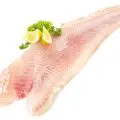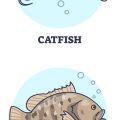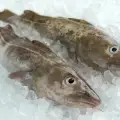Catfish and mackerel are two distinct species of fish that differ significantly in various characteristics such as habitat, physical appearance, and culinary use. Catfish, belonging to the order Siluriformes, are a diverse group of ray-finned fish that are named for their prominent barbels, which resemble a cat’s whiskers. They are found in freshwater environments, as well as in coastal regions around the world. With a reputation for being bottom-dwellers, catfish species exhibit a wide range of sizes and shapes, and they are known for their smooth, scaleless bodies.
Mackerel, on the other hand, are a part of the family Scombridae and are primarily known for their presence in marine settings. These fish are characterized by their slim, torpedo-shaped bodies covered with small, firmly attached scales. Unlike catfish, mackerel have more streamlined bodies designed for speed and are often found in temperate and tropical seas, where they are active swimmers and form large schools. Their flesh is typically rich in omega-3 fatty acids, and they are highly regarded for their importance in both commercial and recreational fishing.
Defining Characteristics
Catfish and mackerel are vastly different fish species with distinct physical characteristics and habitats. Knowing these differences is crucial for identification and understanding their role in marine ecosystems.
Physical Description
Catfish are recognized by their whisker-like barbels around their mouths, which resemble cat whiskers and aid in detecting food. They typically lack scales and have a smooth, often mucus-covered skin, which provides protection. The body shape of catfish can vary, but they usually have a dorsal fin that is long and may contain sharp spines, as well as an anal fin that is also typically long, contributing to their unique silhouette. Their tails are not deeply forked, differing from many other fish species.
Mackerel, on the other hand, have a slender, torpedo-shaped body that is built for speed. They are identifiable by their iridescent skin with vertical stripes on their back. Unlike catfish, mackerel possess a deeply forked tail that aids their swift movement in water. They also exhibit two dorsal fins; the first one with spines and the second one being softer, followed by a series of smaller finlets running along the dorsal and ventral sides toward the forked tail.
Habitat Range
Catfish are predominantly freshwater species, although some are saltwater or brackish water dwellers. They are found in a wide range of water bodies including rivers, lakes, and ponds across the globe. Their habitats can vary from shallow, warm ponds to fast-moving rivers.
Mackerel are primarily saltwater fish, frequenting temperate and tropical seas. They are mostly found in the open ocean, but some species may also be seen near the coast. Mackerel are known for their seasonal migrations in large schools, which are often related to their spawning activities. They generally prefer offshore environments with waters that have a higher dissolved oxygen content and are rich in food sources.
Nutritional Profile
The nutritional profiles of catfish and mackerel differ, specifically in their macronutrients and micronutrient content, each offering unique health benefits.
Macronutrients
Catfish and mackerel offer varying levels of macronutrients.
Catfish:
- Protein: High-quality protein, essential for muscle building and repair.
- Fat: Contains less fat than mackerel, with a mix of saturated and monounsaturated fat.
- Omega-3 Fatty Acids: Lower levels compared to mackerel, but still present.
Mackerel:
- Protein: Also a rich source of protein.
- Fat: Higher fat content, especially omega-3 fatty acids, including EPA and DHA.
- Calories: More calorie-dense due to higher fat content.
Fat content in each fish is a particularly important consideration. Mackerel is rich in heart-healthy omega-3 fatty acids, which are crucial for brain health and reducing inflammation. Catfish has lower levels of omega-3s but is still a nutritious option with less total fat.
Vitamins and Minerals
Both catfish and mackerel are packed with vitamins and minerals, each with its own unique profile.
Catfish:
- Vitamins: Vitamin B12, B3 (niacin), vitamin B6, and vitamin D.
- Minerals: Phosphorus, selenium, and manganese. Lower in mercury, making it a safer choice for regular consumption.
Mackerel:
- Vitamins: High levels of Vitamin B12, D, and selenium.
- Minerals: Rich in iron, zinc, and magnesium. Contains higher levels of vitamin B complex compared to catfish.
While both fish provide essential nutrients, mackerel stands out for its vitamin D and B12 content, both important for bone health and energy metabolism, respectively. It also provides a considerable amount of minerals such as iron and magnesium. Catfish, although lower in omega-3 fatty acids, is still a healthy choice with a strong profile of B vitamins and selenium.
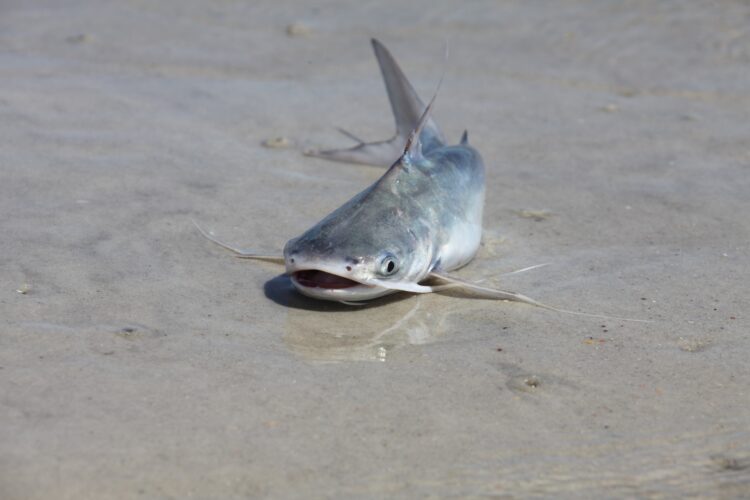
Culinary Uses
Catfish and mackerel have distinct culinary roles due to their texture and flavor profiles.
Cooking Techniques
Catfish is known for its mild flavor and firm texture that lends itself to various cooking methods, including:
- Frying: Often coated in cornmeal and spices before being fried to a golden brown, catfish is a staple in Southern U.S. cuisine.
- Grilling: Can be marinated and grilled, giving it a smokiness that complements its earthy taste.
- Baking: Usually seasoned and baked as a healthier preparation method.
Mackerel, particularly rich in omega-3 fatty acids and with a stronger flavor, is well-suited to:
- Grilling: Ideal for both Spanish mackerel and king mackerel, highlighting their oily texture without drying them out.
- Broiling: High heat cooking that enhances the fish’s natural flavors.
- Smoking: A traditional method that imparts a deep, woodsy flavor, often used for mackerel to preserve the fish and enhance its taste.
Culinary Varieties
Different types of mackerel and catfish offer various culinary experiences:
- Mackerel:
- Spanish Mackerel: A leaner choice with a milder taste, good for light meals.
- King Mackerel: Known for its high-fat content, it is typically heartier and well-suited for robust flavor pairings.
- Catfish:
- Channel Catfish: The most commonly consumed type, often found in freshwater dishes.
- Blue Catfish: Larger and more flavorful, provides a meatier option for main courses.
In comparison with other seafood, catfish’s flavor and texture are less intense than that of tuna, whereas mackerel’s robust taste stands out more, similar to sardines and salmon. Neither catfish nor mackerel has a low glycemic index since they are proteins, not carbohydrates. They can be used as bait for larger species like yellowtail and shad in a pinch but are more popular on the table than in the tackle box. Neither is commonly compared to mild white fish like sole, nor do they have a texture similar to shellfish like shrimp and squid.
Ecological Impact
Catfish and mackerel have distinct ecological impacts, primarily through their roles in food webs and the effects of fishing activities on their populations.
Population and Overfishing
Catfish, abundant in various bodies of water, play a crucial role as bottom-feeders. Their populations can significantly affect aquatic ecosystems. However, certain catfish species have experienced population declines due to habitat destruction and overfishing. For instance, in some regions, overfishing has reduced not only the number of catfish but also disrupted their role in the ecosystem as sediment foragers and scavengers.
Mackerel, on the other hand, are fast-swimming pelagic fish and are known for their schooling behavior. Key mackerel species include the Atlantic mackerel (Scomber scombrus), chub mackerel (Scomber japonicus), cero mackerel (Scomberomorus regalis), and Atlantic horse mackerel (Trachurus trachurus). Overfishing of these species can have a cascading effect on marine ecosystems due to their role as both predators and prey. Overfishing leads to reduced mackerel populations, which has a direct impact on their predators like the wahoo and can also affect the availability of seafood nutrition for humans.
Environmental Influence
Both catfish and mackerel species influence their environments, albeit in different ways. Catfish, which consume a variety of food sources, can alter the composition of benthic organisms in freshwater systems, and in doing so, they can inadvertently affect water quality.
Mackerel perform a vital function through their migratory patterns, contributing to nutrient distribution. Their predatory nature regulates populations of smaller fish and invertebrates. As a result, changes in mackerel populations, due to environmental shifts or overfishing, can lead to imbalances in the food web.
In conclusion, the ecological impacts of catfish and mackerel are significant, with both groups of fish playing key roles in their respective habitats. However, sustainable fishing practices and effective conservation measures are critical to ensure that these species continue to thrive and maintain ecological balance.
Geographical Distribution
The geographical spread of catfish and mackerel varies greatly due to their differing habitats—with catfish commonly found in inland waterways and mackerel in marine environments.
Native Regions
Catfish are a diverse group of ray-finned fish known for their whisker-like barbels. They are predominantly found in freshwater environments such as rivers, lakes, and reservoirs. In the United States, catfish species are native to a wide range of locations, including the Missouri and Ohio rivers. States like Texas also boast a significant catfish population.
Mackerel, on the other hand, are typically saltwater fish residing in the coastal areas of oceans. They are not native to inland waters but instead have a strong presence along various coastlines across the globe, including the Atlantic and Pacific oceans.
Global Presence
Both catfish and mackerel have been noticed for their expansion beyond their native regions, which can be attributed to both natural processes and human activities such as fishing, trade, and aquaculture.
- Catfish: While native to certain regions, catfish have been stocked in other water bodies for sports fishing or aquaculture purposes. Their ability to adapt allows them to thrive both upstream and downstream within diverse ecosystems.
- Mackerel: Mackerel are known for their extensive migrations, greatly extending their global presence. This is especially true for species such as the Atlantic mackerel, which follow warm ocean currents for feeding and breeding purposes. Notably, mackerel do not inhabit inland waterways like rivers or lakes unlike catfish.
Fishing and Farming Practices
Fishing and farming practices for catfish and mackerel vary significantly due to their different habitats and behaviors. Techniques are tailored to the specific species targeted, which can range from shallow-water catfish to fast-swimming mackerels.
Fishery Techniques
For catfish, fishermen typically use a variety of techniques including rod and reel, trotlines, or jug fishing. Bait used often consists of shad, crawfish, and even small chunks of hot dogs or chicken livers. Anglers prefer shallow water areas or places with structures like logs or slate where catfish like to hide and hunt for prey. On the other hand, fishing for mackerel species like Spanish mackerel and king mackerel usually involves trolling or casting with live or artificial lures. Fishermen sometimes employ chumming, a method where baitfish such as anchovies or pieces of shrimp are thrown into the water to attract mackerel and other predators. Mackerel are often found in both coastal areas and open seas, making their fishing techniques diverse.
- Catfish:
- Rod and reel, trotlines, jug fishing.
- Bait: Shad, crawfish, alternative baits.
- Mackerel:
- Trolling, casting, chumming.
- Bait: Live bait (anchovies, shrimp), artificial lures.
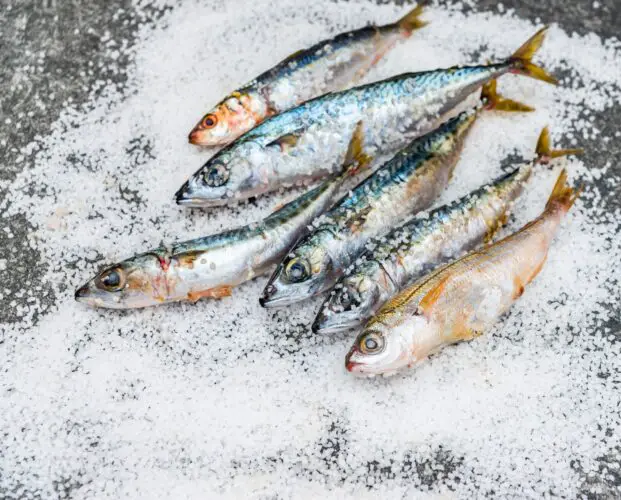
Aquaculture Methods
In aquaculture, catfish are often farmed in freshwater ponds where they can be fed a diet of pelletized food, which can include plant-based materials and animal proteins such as shrimp or fish byproducts. The ponds are typically shallow and sometimes lined with slate to replicate a bottom substrate that catfish prefer for laying eggs. Mackerel, however, are not commonly farmed due to their migratory nature and requirement for large swimming spaces. In certain cases, mackerel species like the tuna are ranched where young fish are captured and grown in large offshore pens, but such practices are less common with mackerel when compared to tuna.
- Catfish Farming:
- Freshwater ponds, controlled feed.
- Environment: Shallow, sometimes slate-lined ponds.
- Mackerel Farming:
- Not commonly farmed.
- Tuna ranching can be analogous but is less prevalent for mackerel.
Health Considerations
When comparing the health implications of consuming catfish and mackerel, it’s essential to consider their nutritional composition and how they can affect overall well-being, including their benefits and potential risks.
Benefits
Catfish is known for its low-calorie count and is a good source of protein and vitamins such as B12. In terms of minerals, catfish provides a notable amount of calcium and iron. However, it typically has less omega-3 fatty acids compared to other seafood options.
- Protein: Essential for muscle repair and growth.
- Calcium: Vital for bone health.
- Iron: Crucial for blood health and energy levels.
Mackerel, on the other hand, is a rich source of these heart-healthy omega-3 fatty acids, which can help reduce inflammation and may lower the risk of heart disease. Vitamins found in mackerel include a variety such as vitamin D and many from the B complex. Minerals such as selenium are also abundant in mackerel, contributing to its powerful health benefits.
- Omega-3 Fatty Acids: Reduce inflammation and support heart health.
- Selenium: Important for immune function and thyroid health.
| Nutrient | Catfish | Mackerel |
|---|---|---|
| Protein | High | High |
| Omega-3 | Lower than other fatty fish | High |
| Vitamins | B12, D | D, B complex |
| Minerals | Calcium, Iron | Selenium, Iron |
Risks
While both fish can be healthy options, certain risks are associated with them. Catfish raised in environments with poor water quality can accumulate contaminants and may have higher levels of saturated fat and cholesterol compared to wild-caught options. It is significant to note that farm-raised catfish often have more regulated diets and environments, potentially reducing these risks.
In the case of mackerel, certain varieties like king mackerel can contain high levels of mercury, which can be a concern for pregnant women and young children. It is generally advised to opt for smaller mackerel species, such as Atlantic mackerel, which have lower mercury content.
Other seafood to consider concerning mercury content includes swordfish, shark, albacore, and orange roughy. While halibut, cod, and haddock have less mercury, moderation is still important.
| Seafood | Mercury Consideration |
|---|---|
| Large Mackerel | High mercury, exercise caution |
| Albacore | Moderate mercury, exercise caution in certain populations |
| Swordfish | High mercury, limit intake |
| Shark | High mercury, limit intake |
Ensuring that either fish is consumed in moderation, alongside various other seafood like clams and halibut, can contribute to a balanced and nutritious diet. It is also crucial to consider preparation methods, as added sugar, sodium, and cooking fats can impact the health benefits of these otherwise nutritious fish.

